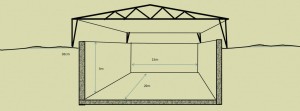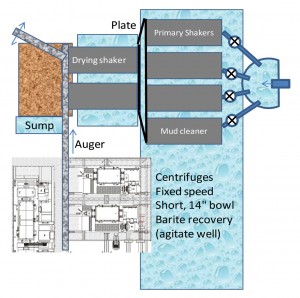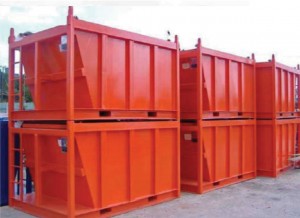Waste handling under study for Chinese unconventional wells
Operators look to recycling, pitless approach to manage drilling, fracturing stimulation waste
By Jiaqi Zhu, Gerard de Blok, Shell China; Jie Chen, PetroChina

Waste management plays an important role in delivering an environmentally sound well. If a project requires the operator to drill hundreds of deep development wells, and in close vicinity of communities, waste management becomes an even more critical success factor. There is simply no room for error.
The drilling and stimulation of these large numbers of wells will generate large volumes of solids and fluid waste, which must be managed efficiently, strictly controlled and comply with the requirements of local regulators.
Waste generated during the drilling phase constitutes of water-based mud (WBM) cuttings, synthetic-based mud (SBM) cuttings and WBM fluids, whereas frac flowback water will be the constituent following fracturing stimulation.
Challenges to waste management can include heavy land transportation, resistance from local farmers in a populated area, meeting the strict and mandatory requirements from China’s Environmental Protection Bureau (EPB), while at the same time aiming for overall well cost reduction and project delivery. Another limiting factor is the number of qualified local waste disposal vendors in the Sichuan area of China.
Shell E&P China operates two unconventional gas projects onshore – Fushun (appraising shale gas) and Jinqiu (appraising tight gas), located in the Sichuan Basin. The projects cover an approximate area of 7,500 sq km that includes low hills and alluvial plains.

In the Fushun and Jinqiu wells, top-hole and intermediate hole sections are drilled with WBM. Wet cuttings are brought to surface by drilling fluid during the drilling and circulation phases. For this reason, WBM cuttings are generated in every well, contributing to a major stream of solid waste (Figure 1). It is the intention to reuse large volumes of WBM fluids in similar-sized hole sections and for many wells. If WBM waste fluids cannot be reused or recycled as a result of severe contamination, deterioration or unacceptable high cost limitations, then this has to be disposed of. Volumes of WBM waste fluid vary case by case. It should be noted that both WBM cuttings and WBM fluids are classified as non-hazardous waste.
In Fushun and Jinqiu, the reservoir sections are drilled with SBM, and cuttings contaminated with residual base oil (usually synthetic saraline) are classified as hazardous waste. The volume of SBM cuttings is substantially less than that of WBM cuttings because of the reduced hole size across the reservoir sections (Figure 1). Nonetheless, given the nature of SBM cuttings, these waste streams have to be treated in accordance with a strict disposal protocol following country and regional regulatory requirements.
Fracturing stimulation is a must for unconventional gas wells. All Fushun and Jinqiu wells are stimulated by frac water. During the flowback period, a substantial volume of frac water, entrained with formation fluid, will always return to surface. On most wells that have been fractured, flowback water constitutes thousands of cu meters per well (Figure 1). Frac flowback water is classified as non-hazardous waste.
To ensure that all of these waste streams were covered in an integrated waste management system, the project team of both Fushun and Jinqiu initiated a plan to cover waste generation, waste transportation, final disposal process and a waste tracking system as per ISO guidelines and in agreement with the company’s global HSE policy and procedures.
Waste disposal phase I solution

Waste management is divided in two phases. In phase I, a solution was sought to use a recycling method in the field, and in doing so minimize the generated waste volumes. This solution was made up of a disposal waste stream for each waste category.
The solution had to suit the local circumstances and enable the drilling schedule to be executed timely, i.e., with the first well spud within eight months of the agreement being signed. For that reason, a final decision was taken to solidify of all WBM cuttings followed by burial in-situ, with the added benefit that it would minimize the impact on drilling operations.
The first series of well site locations in the Fushun and Jinqiu projects were designed with waste pit dimensions of 20 meters long by 15 meters wide by 4 meters deep (Figure 2), providing a 1,200-cu-meter volume capacity. WBM cuttings returned to surface would be discharged by solid control equipment (Figure 3) and collected in a 3-cu-meter cuttings skip using an auger system. Full cuttings skips would be emptied into a 15-cu-meter cuttings-mixing box for pre-treatment.
A digger was used to solidify the WBM cuttings by mixing cuttings with chemicals (cement and additives). This mixture of solids would later be dumped into a waste pit for burial in-situ. The waste pit capacity is designed to accommodate all of the WBM cuttings volume from top-hole and intermediate-hole sections. After the intermediate casing cementation, the waste pit area would be covered by an approximate 20-cu-meter concrete layer on top, which would function as pit remediation.
The solidified solids would be cored for lab test as per EPB requirement.
The frac flowback water from Fushun shale gas wells is primarily “slick” water, which is transported by tanker trucks to industrial waste plants for final disposal. In contrast, frac flowback water comprises more gel from Jinqiu tight-gas wells, and it requires a flocculation and precipitation pre-treatment in-situ before transportation to an industrial waste plant.
The flocculated solids are solidified followed by a burial in-situ, much the same method as for WBM cuttings.
WBM waste fluid is generally dirtier and heavier than frac flowback water. Therefore, it has to be stored temporarily in a waste pit for solids to drop out. The lighter fluid above the sediment often requires a similar flocculation and precipitation pre-treatment and is then transported to an industrial waste plant for final disposal. The heavier fluids, along with the settled solids, are solidified and buried in-situ, again much the same as for WBM cuttings.
Solidification and burial in-situ for WBM cuttings, pre-treatment and then transporting effluents to industrial waste plants for WBM waste fluid and frac flowback water has proven to be a workable and efficient solution. It’s the conventional way of non-hazardous drilling and stimulation waste handling in the Sichuan basin.
In contrast, SBM cuttings are classified and therefore treated as hazardous waste and are preferentially incinerated in a hazardous waste disposal plant. The approach in the Fushun and Jinqiu projects was and continue to be to use 3-cu-meter cutting skips (Figure 4) to collect all of the SBM cuttings downstream of solids control equipment, then mobilize cutting trucks to transport these skips away. The skips are fitted with a sealed lip on top, thus mitigating and avoiding spill incidents during transportation of these skips to hazardous a waste disposal plant.
Challenges
There are many challenges to address, such as transportation of cuttings skips and fluids over treacherous road conditions and long transportation distances. But the operator is determined to meet the strict and mandatory requirement of EPB while aiming for overall well cost reduction and timely project delivery.
In the Fushun and Jinqiu projects, a Safe Journey Management Plan (SJMP) was implemented to ensure a control system is in place for all waste-handling transportation. When the waste disposal vendors receive a call-off from the field, they must forward an SJMP to the site supervisor to obtain approval and prior dispatching of any trucks.

Driver contact and truck information, routing map, work/rest schedule and emergency contacts, etc, should be all be captured in the SJMP.
In addition, a waste-tracking monitoring system has been developed to function as an assurance control component. The generated waste volume from drilling rig and fracturing unit is also recorded in the daily drilling and/or completion and well intervention reports. Thereafter, the waste volume received by the disposal plant or landfill location is reported to the contract holder. As long as the generated volume from the onsite location is equal to that of the disposed-of volume, it assures that all waste streams have been transported to their final destination as planned and in an environmentally sound manner.
The waste disposal process in Fushun and Jinqiu were summarized in an Environment Impact Assessment/Forum (EIA/F) and submitted to the EPB for approval, with the operator’s environmental team reporting to EPB with the latest operational update.
A restricting factor is the number of qualified local waste disposal vendors in the Sichuan area. The selected vendors rarely have experience in dealing with the oil and gas industry. In the Fushun and Jinqiu projects, waste disposal vendors were trained in applying the permit-to-work system, the job hazard analysis system and Shell’s Life Saving Rules. Vendor staff also attended the defensive-driving course and participated in the waste disposal on paper, all prior to any dispatch of hazardous waste.
Given the crew turnover, frequent training sessions and pursuing rigorous implementation of mandatory procedures will always remain an absolute necessity.
Waste disposal phase II solution
When projects require the operator to drill hundreds of deep development wells and in close vicinity of communities, keeping a 20-meter by 15-meter waste pit as part of the well site location may prove to be a major hurdle in terms of land acquisition. In addition, waste pit construction is also time- and cost-consuming affair. Therefore, it was no surprise that a pitless drilling and stimulation location becomes a more attractive solution for waste disposal.
In a pitless approach, handling of WBM cuttings has a major impact on the waste management process. It demands transporting vast amounts of solidified cuttings to an industrial waste landfill, rather than burial in-situ.
The operators’ current practice is to mobilize six 15-cu-meter cutting boxes to the well site. The solidified cuttings would be temporarily stored in cutting boxes for approximately eight hrs, in line with the solidification process.
The cuttings mass is then dug out and dropped into cuttings trucks for transportation. The cuttings moved by cuttings trucks are relatively dry after the solidification, thus mitigating or even avoiding a potential spill risk during its transport to the waste disposal site.
WBM waste fluids and the frac flowback water handling process have also been revised. Instead of a pretreatment in-situ, effluents are moved by tanker trucks to an industrial sewage plant for treatment and final disposal.
It stands to reason that, with the new pitless approach, land transportation has become a major element of the operator’s waste management philosophy.
Waste disposal future solution
In the long term, the operator aims to make it possible to have bricks made from the WBM solidified cuttings, preferably with a brick-making construction site. This would have to be inside the concession block to minimize transportation. These bricks could be used by the local population for water ditches, sunken fences and foot paths.
By following this approach, the operator could “hand over” the waste pit on a drilling or stimulation site to a brickmaking vendor. The same method could be applied to industrial landfills. The challenge is to demonstrate that the bricks will not be associated with any hazard during or after its use. The proposal would also have to be captured in an EIA/F report prior to submission for approval by EPB. This study work is ongoing.
There is also a water-cleaning technology available to treat the frac flowback water for recycling and reuse.
However, the main drawback is added cost. A trial to recycle frac flowback water as an injection fluid for stimulation was carried out in Fushun. The long-term plan is to have zero discharge for frac flowback water.
In terms of SBM cuttings, vertical dryers are being designed to reduce the base oil content in cuttings to acceptable levels prior to disposal. The next step would be to biodegrade OBM cuttings to non-hazardous waste, making it acceptable as landfill.
Conclusion
The work presented here is a case study for waste management in unconventional gas wells in Sichuan, China. A pitless waste disposal approach minimized the environmental impact and still secured the drilling and frac stimulation operations. However, given the challenges related to heavy land transportation, cost reduction and concerns from those living in the vicinity of these sites, the Fushun and Jinqiu project teams are working to further optimize the waste management system in a more innovative way.
This article is based on a presentation at the 2012 IADC/SPE Asia Pacific Drilling Technology Conference and Exhibition, 9-11 July, Tianjin, China.




